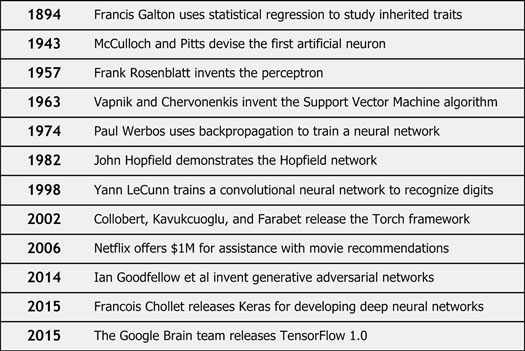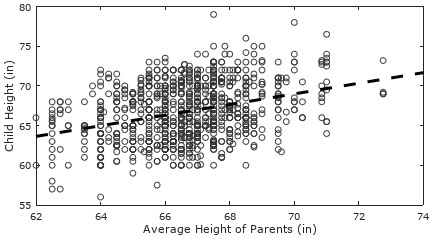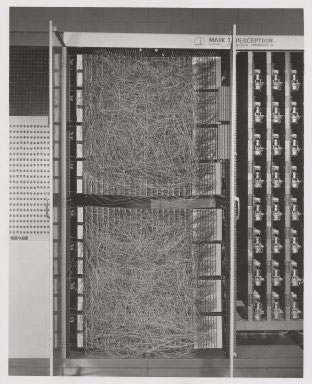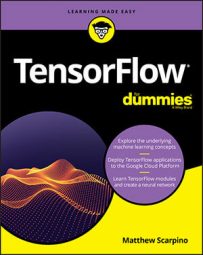 Developments in machine learning extend from academia to corporations.
Developments in machine learning extend from academia to corporations.After you understand why researchers and corporations have spent so much time developing the technology, you’ll better appreciate why studying TensorFlow is worth your own time.
Statistical regression
Just as petroleum companies drill into the ground to obtain oil, machine learning applications analyze data to obtain information and insight. The formal term for this process is statistical inference, and its first historical record comes from ancient Greece. But for this purpose, the story begins with a nineteenth-century scientist named Francis Galton. Though his primary interest was anthropology, he devised many of the concepts and tools used by modern statisticians and machine learning applications.Galton was obsessed with inherited traits, and while studying dogs, he noticed that the offspring of exceptional dogs tend to acquire average characteristics over time. He referred to this as the regression to mediocrity. Galton observed this phenomenon in humans and sweet peas, and while analyzing his data, he employed modern statistical concepts like the normal curve, correlation, variance, and standard deviation.
To illustrate the relationship between a child’s height and the average height of the parents, Galton developed a method for determining which line best fits a series of data points. This figure shows what this looks like. (Galton’s data is provided by the University of Alabama.)
 Linear regression identifies a clear trend amidst unclear data points.
Linear regression identifies a clear trend amidst unclear data points.Galton’s technique for fitting lines to data became known as linear regression, and the term regression has come to be used for a variety of statistical methods. Regression plays a critical role in machine learning, and Chapter 6 discusses the topic in detail.
Reverse engineering the brain
In 1905, Ramón y Cajal examined tissue from a chicken’s brain and studied the interconnections between the cells, later called neurons. Cajal’s findings fascinated scientists throughout the world, and in 1943, Warren McCulloch and Walter Pitts devised a mathematical model for the neuron. They demonstrated that their artificial neurons could implement the common Boolean AND and OR operations.While researching statistics, a psychologist named Frank Rosenblatt developed another model for a neuron that expanded on the work of McCulloch and Pitts. He called his model the perceptron, and by connecting perceptrons into layers, he created a circuit capable of recognizing images. These interconnections of perceptrons became known as neural networks.
Rosenblatt followed his demonstrations with grand predictions about the future of perceptron computing. His predictions deeply influenced the Office of Naval Research, which funded the development of a custom computer based on perceptrons. This computer was called the Mark 1 Perceptron, and this figure shows what it looks like.
 Credit: Cornell Aeronautical Laboratory.
Credit: Cornell Aeronautical Laboratory.The Mark 1 Perceptron was the first computer created for machine learning.
The future of perceptron-based computing seemed bright, but in 1969, calamity struck. Marvin Minsky and Seymour Papert presented a deeply critical view of Rosenblatt’s technology in their book, Perceptrons (MIT Press). They mathematically proved many limitations of two-layer feed-forward neural networks, such as the inability to learn nonlinear functions or implement the Boolean Exclusive OR (XOR) operation.
Neural networks have progressed dramatically since the 1960s, and in hindsight, modern readers can see how narrow-minded Minsky and Papert were in their research. But at the time, their findings caused many, including the Navy and other large organizations, to lose interest in neural networks.
Steady progress
Despite the loss of popular acclaim, researchers and academics continued to investigate machine learning. Their work led to many crucial developments, including the following:- In 1965, Ivakhnenko and Lapa demonstrated multilayer perceptrons with nonlinear activation functions.
- In 1974, Paul Werbos used backpropagation to train a neural network.
- In 1980, Kunihiko Fukushima proposed the neocognitron, a multilayer neural network for image recognition.
- In 1982, John Hopfield developed a type of recurrent neural network known as the Hopfield network.
- In 1986, Sejnowski and Rosenberg developed NETtalk, a neural network that learned how to pronounce words.
The computing revolution
As the 1980s progressed into the 1990s, improved semiconductor designs led to dramatic leaps in computing power. Researchers harnessed this new power to execute machine learning routines. Finally, machine learning could tackle real-world problems instead of simple proofs of concept.As the Cold War intensified, military experts grew interested in recognizing targets automatically. Inspired by Fukushima’s neocognitron, researchers focused on neural networks specially designed for image recognition, called convolutional neural networks (CNNs). One major step forward took place in 1994, when Yann LeCunn successfully demonstrated handwriting recognition with his CNN-based LeNet5 architecture.
But there was a problem. Researchers used similar theories in their applications, but they wrote all their code from scratch. This meant researchers couldn’t reproduce the results of their peers, and they couldn’t re-use one another’s code. If a researcher’s funding ran out, it was likely that the entire codebase would vanish.
In the late 1990s, one problem facing researchers was that, while machine learning theory was mature, the process of software development was still in its infancy. Programmers needed frameworks and standard libraries so that they weren’t coding everything by themselves. Also, despite Intel’s best efforts, practical machine learning still required faster processors that could access larger amounts of data.
The rise of big data and deep learning
As the 21st century dawned, the Internet’s popularity skyrocketed, and the price of data storage plummeted. Large corporations could now access terabytes of data about potential consumers. These corporations developed improved tools for analyzing their data, and this revolution in data storage and analysis has become known as the big data revolution.Now CEOs were faced with a difficult question: How could they use their wealth of data to create wealth for their corporations? One major priority was advertising — companies make more money if they know which advertisements to show to their customers. But there were no clear rules for associating customers with products.
Many corporations launched in-house research initiatives to determine how best to analyze their data. But in 2006, Netflix tried something different. They released a large part of their database online and offered one million dollars to whoever developed the best recommendation engine. The winner, BellKor’s Pragmatic Chaos, combined a number of machine learning algorithms to improve Netflix’s algorithm by 10 percent.
Netflix wasn’t the only high-profile corporation using machine learning. Google’s AdSense used machine learning to determine which advertisements to display on its search engine. Google and Tesla demonstrated self-driving cars that used machine learning to follow roads and join traffic.
Across the world, large organizations sat up and paid notice. Machine learning had left the realm of wooly-headed science fiction and had become a practical business tool. Entrepreneurs continue to wonder what other benefits can be gained by applying machine learning to big data.
Researchers paid notice as well. A major priority involved distinguishing modern machine learning, with its high complexity and vast data processing, from earlier machine learning, which was simple and rarely effective. They agreed on the term deep learning for this new machine learning paradigm.

